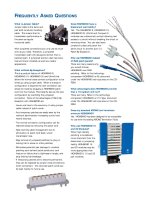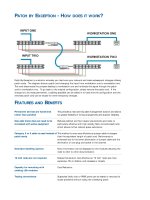KRONE - Guide Book - Structured Cabling System Overview
Bạn đang xem bản rút gọn của tài liệu. Xem và tải ngay bản đầy đủ của tài liệu tại đây (193.55 KB, 19 trang )
St r u ct u r e d Ca blin g Sy st e m ( SCS)
D e finit ion
A structured cabling system (SCS) is a set of cabling and connectivity products
that integrates the voice, data, video, and various management systems of a
building (such as safety alarms, security access, energy systems, etc.).
Ove r vie w
An SCS consists of an open architecture, standardized media and layout,
standard connection interfaces, adherence to national and international
standards, and total system design and installation. Other than the structured
cabling system, voice, data, video, and building management systems (BMS) have
nothing in common except similar transmission characteristics (analog or digital
data signals) and delivery methods (conduit, cable tray, raceway, etc.) that
support and protect the cabling investment. This tutorial discusses the elements
of a structured cabling system and the operational advantages such an approach
may enable.
Topics
1. Introduction
2. The Foundation for Systems Integration
3. Planning
4. Structured Cabling for Building Management Systems
5. Bid Specifications
6. Integrated SCS Cost Comparison: Overview
7. Integrated SCS Cost Comparison: Construction Costs
8. Integrated SCS Cost Comparison: Labor Hours
9. Integrated SCS Cost Comparison: Operational Costs
10. Summary
Self- Test
Correct Answers
Glossary
1 . I n t r odu ct ion
Providing an internationally standardized SCS and consolidating cable-delivery
methods for all the systems can reduce initial construction costs for the cabling
infrastructure of a modern intelligent building by up to 30 percent. The actual
level of savings achieved depends upon the configuration and geographical
pricing for material and labor. This also gives the structure an inherent ability to
respond quickly and cost-effectively to the changing needs of tenants, which
impacts the cost to occupy the space. In some cases, additional construction
expenditures for the SCS or BMS, such as devices to optimize the use of power
consumption, may be necessary to reduce the operational expenses. However, the
costs for cabling-related changes can typically be reduced by 25 to 40 percent—
with possible savings of up to 60 percent—for a new or renovated facility when
using a total systems integration approach.
As Figure 1 indicates, typical costs for building operation and alterations over a
40-year life cycle far exceed the initial construction costs. Proper systemsintegration planning to optimize the construction process can reduce these
ongoing life cycle costs.
Figu r e 1 . Ty pica l Cost s for a SCS
2 . Th e Fou nda t ion for Syst e m s I n t e gr a t ion
For many years voice and data systems were cabled separately. Now it is standard
practice to use a common SCS for both of these systems. Like the voice and data
systems of the past, the traditional construction process separately installs each
of the BMS disciplines under various divisions of a specification. The BMS
typically consists of the following:
•
fire, life, and safety (FLS) or fire alarm (FA)
•
security and access control (SAC)
Web ProForum Tutorials
Copyright ©
The International Engineering Consortium
2/19
•
energy management systems (EMS)
•
heating, ventilation, and air conditioning (HVAC)
These BMS categories are typically cabled separately by the mechanical and
electrical specifications. The voice and data cabling is rarely addressed during
construction and is usually not part of the construction budget. Planning and
installation are normally accomplished when the floor space is being prepared for
occupancy. This means multiple cabling systems and cable delivery methods are
installed during various stages of the construction.
With proper planning, the only limiting factor for complete systems integration
of the voice, data, video, and BMS may be the FA system. In the United States,
Article 760-54 (b) of the 1996 National Electrical Code (NEC) allows conductors
of power-limited FA systems and signaling/communications circuits (Article
725/800) to share the same cable, enclosure, or raceway. In addition, Article
760-61 (d) of the NEC allows the use of the same type of cable for FAs that is
typically used for the signaling/communications (voice and data) circuits. Some
local codes however, especially codes in other countries, may invoke limitations
or require special approvals for integrating the FA system. Yet, even if the FA
cabling is installed separately, there are still substantial cost reductions and
benefits that can be derived from integrating the remaining BMS.
In addition to the code requirements, there is also a need to evaluate the
electrical characteristics of the systems. The voice and data systems primarily
consist of analog and digital signals and have established guidelines for signal
strength over distance. The BMS devices operate on current draw, circuit
resistance (contact closure), or consist of analog or digital signals. Basically, each
BMS terminal or device will operate over a particular cable type as long as it is
located within a specified range from the equipment.
BMS devices are utilized to monitor or control a specific function. This can be
equated to an output from the equipment or an input from a device. As an
example, there may be a temperature sensor that gathers information and sends
a signal to the equipment panel (input) and, as a consequence, the equipment
sends a signal to a device that closes a damper or vent (output). Devices are
primarily power-limited or communicate using low-speed protocols. The signal
distance supported by the devices is usually limited by the current draw and line
voltage delivered by the power supply. Typically, 24–American wire gauge
(AWG) unshielded twisted-pair (UTP) cable has the capacity to handle 1 Ampere
(Amp) of current draw per conductor, with a maximum of 3.3 Amps per four-pair
cable.
What does this mean? The current or signal from the equipment leaves at the
specified voltage level. The device requires a certain voltage level to operate. As
the signal travels through the cable, the voltage drops due to resistance. Cable
Web ProForum Tutorials
Copyright ©
The International Engineering Consortium
3/19
pair resistance is measured by shorting one end of the cable and taking a
resistance reading between the conductors at the other end. A typical 24–AWG
UTP cable pair has 57.2 Ohms of resistance per one-thousand feet or .0572 Ohms
per foot. Circuit resistance can be measured by dividing the voltage drop by the
current draw.
If a 24 Volt (V) device requires .05 Amps of current to operate and the allowable
voltage drop is ±10 percent, or 2.4V, the maximum circuit distance using 24–
AWG UTP cable is 839 feet (256 meters). This can be easily calculated for any
cable and circuit using the following two-step formula:
1. voltage drop (2.4 V)/current draw (.05 Amps) = circuit resistance (48
Ohms)
2. circuit resistance (48 Ohms)/1 foot cable resistance (.0572 Ohms) =
maximum distance (839 feet/256 meters)
Some equipment vendors state that a lower-gauge cable, such as 18 AWG, is
required for proper system operation. This is typically found to be unnecessary
once the electrical characteristics of the system are analyzed.
3 . Pla n n in g
Statements in previous modules of this tutorial have established that it is possible
to use the same type of 24–AWG UTP cable and share a common cable delivery
method for all power-limited services. The next step is to determine the best way
to perform systems integration. The process starts with early planning and a
decision by the building owner or management to select the cabling as the first
system. Once the decision is made to use a common cabling infrastructure, it is
very easy to select voice, data, video, and BMS equipment that is compatible with
the cabling. In fact, the sooner the consolidation of cabling systems and delivery
methods is considered, the greater the potential savings and flexibility.
The Electronic Industries Association/Telecommunications Industry Association
(EIA/TIA) and International Standards Organization/International
Electrotechnical Commission (ISO/IEC) have created industry standards for
cabling voice and data systems. These standards address the cabling and cabledelivery methods (pathways and spaces) and are based on a structured subsystem
architecture or cabling elements (see Figure 2). Prior to the standards, the
subsystem concept was first used for voice systems. During the 1980s, it was also
adopted for data systems. Like the BMS equipment of today, there were many
different types of cables and wiring methods for data systems before the
standards were established. Data networks were typically unmanageable, with
little or no flexibility, and new cabling was often necessary when systems were
changed or upgraded.
Web ProForum Tutorials
Copyright ©
The International Engineering Consortium
4/19
Figu r e 2 . Sub syst e m Ar chit e ct ur e
With some slight modifications (e.g., use of a coverage area), the EIA/TIA and
ISO/IEC documents can also be used to provide the same standardized cabling
architecture for the BMS devices, systems, and applications. The cabling and
cable-delivery methods can be designed for all the services with the
telecommunications closet (TC) as the terminating point for horizontal cables.
This is the key to the integration of cabling and delivery methods. The
wallfields/distribution frames at the TC location can be combined for maximum
flexibility, or individual termination fields can be established within the same TC.
Therefore, a secure area for all cabling is created, thus reducing the multiple
spaces required for traditional separate installations. Maintenance is also
simplified since all systems are located in a common area.
Standardized cabling architecture allows a single delivery method to be designed
for supporting the various horizontal cables in the work space. It can be taken a
step further by incorporating the horizontal electrical services from the electrical
panel into a modular partitioned raceway. This can be used instead of a
traditional hardwired installation consisting of several conduit and cable-tray
systems for the voice, data, video, BMS, and electrical services. Case studies show
that an integrated approach can provide up to a 30-percent construction savings
for cabling and delivery methods when a single high/low voltage cabling
infrastructure is implemented. The majority of savings is attributed to the
reduction in the amount of labor hours. By reducing labor hours, the space can
typically be occupied at an earlier date. This means saving money by vacating
other leased spaces sooner or collecting additional revenue from tenants that will
occupy the new space.
Even if an integrated high/low voltage raceway system is not utilized, the
methods of delivery may be consolidated by using one cable-tray system for all of
the power-limited services. Conduit can also be provided from the cable tray to
protect critical services. With either choice, with early planning comes the ability
Web ProForum Tutorials
Copyright ©
The International Engineering Consortium
5/19
to evaluate all the services and consolidate individual voice, data, video, and BMS
using a single cable type and delivery method instead of multiple cable types and
delivery methods.
Figu r e 3 . Se pa r a t e Sy st e m s Appr oa ch Usin g M u lt iple H a r dw ir e d
Ca ble - D e live r y M e t hods
Figu r e 4 . I nt e gr a t e d Syst e m s Appr oa ch Using M odu la r Ra ce w a y
a nd Ope n Off ice Ca bling
The building's tenants can also realize significant savings. A traditional facility
with leased space may not provide horizontal cabling for any services. This makes
the setup time for tenants longer. In addition, the tenant usually pays for the
voice and data cabling, along with the cost of occupying the space during setup.
The cost and setup time for the tenant can be dramatically reduced by installing
Web ProForum Tutorials
Copyright ©
The International Engineering Consortium
6/19
an open office horizontal cabling grid during the construction phase. Open-office
cabling, which is actually another term for prewired zone cabling, provides a
building with a marketable advantage that could mean the difference between
empty space and occupied space. One month of full occupancy could pay for the
entire cabling system.
With open-office cabling fast becoming the preferred method of cabling for both
new construction and renovations, it is possible to provide a cabling design
without knowing where any of the devices will be located. The entire design for
the cabling can be based on the maximum usage of the size and type of space. As
an example, a typical voice and data work area for an office can be located every
100 square feet (9 square meters), and the BMS devices can be calculated based
on every 250 square feet (23 square meters). Even if an open-office cabling
approach is not utilized, costs can still be reduced by consolidating the cabledelivery methods for the voice, data, video, and BMS services.
Historically, voice and data horizontal cabling has not been installed during the
construction phase. Installing cabling during the construction phase is easier,
minimizes damage to finished surfaces, and is reusable for the life of the
structure when designed properly. New cabling does not have to be installed
every time the tenants move, or when systems are changed or upgraded. This
helps to eliminate cluttered floor and ceiling spaces. In addition, constant
rewiring within a structure tends to cause modifications that may affect the
physical structure of the building and the integrity of the technology deployed in
the structure. As seen in Figure 5, systems will change many times during the life
of a structure. With proper planning, it is not necessary to provide new cabling
every time systems are changed or upgraded.
Figu r e 5 . Lif e - Cycle D ia gr a m
Web ProForum Tutorials
Copyright ©
The International Engineering Consortium
7/19
4 . St r u ct u r e d Ca blin g for t h e BM Ss
The SCS can provide up to a 15-percent construction savings for just the BMS
installation. A traditional installation uses a heavier gauge cable which, per foot,
is typically more expensive. An SCS approach provides additional components,
such as administration (cross connects), equipment cabling, and a multipair
riser. These SCS components, which are part of the SCS subsystem architecture,
can make it possible to reduce the number of equipment panels required for the
BMS configuration. In addition, since a riser backbone is required for the voice
and data, it is very cost-effective to increase the riser cable size for the BMS
services.
The SCS subsystem cabling approach allows the BMS equipment to be
centralized, thus fully utilizing all of the available equipment ports. Any power
required to operate devices, such as FA strobes or variable volume air boxes, can
be distributed from the TC locations or provided locally. This may necessitate
additional BMS hardware for the SCS approach since 24–AWG cable will
typically power less devices per cable. However, this situation could be alleviated
if BMS power supplies were manufactured with more power taps that supplied
less current per tap. The power taps could even be modular with multiple
appearances on a jack, which would also simplify the installation.
On the other hand, a traditional BMS installation typically distributes the
equipment panels. This leaves many unused ports scattered around a facility and
usually requires more equipment panels than a centralized approach. Since the
traditional installation has no administration subsystem, it is neither practical
nor cost-effective to run the device cables to a central equipment location.
Centralization of the BMS equipment, which can be used for most structures, is
possible because of the SCS subsystem architecture. This solution can be equated
to a typical private branch exchange (PBX) installation, which uses a centralized
approach for providing service. A distributed PBX architecture (remote PBX
cabinets) will not be used unless the distance limitations are exceeded.
Using a distributed equipment approach is typically not cost-effective for most
types of equipment or systems. Sometimes the system limitations for data
transmission or power require a distributed topology, but this is usually not the
case for the typical low-speed and power-limited BMS equipment. Using a
centralized SCS solution can reduce the combined cabling and equipment costs as
well as reduce the multiple spaces typically required to house the equipment.
Web ProForum Tutorials
Copyright ©
The International Engineering Consortium
8/19
Figu r e 6 . Tr a dit ion a l D ist r ibut e d Appr oa ch ve r su s SCS
Ce nt r a liz e d Appr oa ch
Installation, testing, and the electrical costs for the panels can also be reduced
with a centralized equipment approach. Additionally, if an equipment panel fails,
the ports can be easily reconnected to another equipment panel and retranslated.
In a traditional installation, the panel—or components within the panel—would
have to be replaced in order to restore service. Some vendors state that the panels
must be placed in close proximity to the mechanical equipment for
troubleshooting, but an RJ45-type outlet can provide plug-in capabilities for a
remote hand-held tester. Centralization also allows ports from the same
equipment panel to be dynamically alternated throughout a structure, which
alleviates complete failures on any given floor or area if an equipment panel fails.
The subsystem cabling approach also makes upgrades for the BMS equipment
faster and more cost-effective. In a traditional installation, devices are wired
straight from the equipment panel to the device. When the panel needs to be
upgraded, the cables have to be reterminated in the new panel. This is not always
easy or practical, and sometimes the device cables may not be reusable. With the
subsystem cabling approach, at worst, a new equipment subsystem is provided
and the devices are reconfigured at the cross connect location. The SCS approach
assures economical upgrades to the equipment with minimal service outages.
Data-transmission speed is rising as technology advances and more information
is processed. As the BMS equipment becomes more advanced, its associated datatransmission speeds will also increase. Currently, some of the traditional BMS
cabling will only support limited data rates and applications. If the right cabling
is not incorporated into the structure during construction, it may require new
cabling in the future.
Web ProForum Tutorials
Copyright ©
The International Engineering Consortium
9/19
5 . Bid Spe cifica t ion s
Systems integration can easily be accomplished with the proper bid specifications
and a decision by the building owner, developer, or executive management to
select the cabling system first. Each individual equipment specification should
provide, or refer to, an overview of the systems-integration concept and define
the scope of work responsibilities by SCS subsystem for the equipment vendor
and cabling contractor. The electrical characteristics of the cabling should also be
included in the specification to assure systems performance.
Once this has been provided, a bid specification for the cabling and delivery
methods can be defined to integrate all the systems. By using this systemsintegration approach, it is possible to reduce each equipment vendor's bid by 20
to 30 percent since cabling, delivery methods, and cable-path engineering will be
provided by an integrated cabling specification.
6 . I n t e gr a t e d SCS Cost Com pa r ison:
Ove r vie w
This cost model compares a traditional separate systems installation to a singly
designed and installed SCS. The approach can be applied to any new or renovated
building project. In this case, the traditional approach uses multiple cable types
and delivery methods. The SCS method uses the same cable type for all the voice,
data, video, and BMS services with a common delivery method for all horizontal
low-voltage and high-voltage services. The SCS open-office cabling approach also
provides for additional horizontal coverage with 599 spare outlets.
Ta ble 1 . I nt e gr a t e d SCS Cost Com pa r ison
Pr e m ise s
Conf igu r a t ion
Tr a dit iona l
SCS
floors
5
5
square feet
100,000
100,000
square meters
9,294
9,294
horizontal cabling
homerun
open office
cable delivery
conduit/tray
raceway
work areas
850
850
voice/data outlets
1,700
1,700
spare outlets
0
599
BMS devices
400
400
electrical circuits
257
257
Web ProForum Tutorials
Copyright ©
The International Engineering Consortium
10/19
The following three modules contain the construction, labor, and operational
comparisons based upon this configuration. Please note that the actual level of
savings achieved depends on the configuration and the actual prices for material
and labor. Also note that the spare-outlet capacity can be adjusted to meet
customer needs, but 25 to 35 percent of the total voice, data, video, and BMS
outlets is recommended. All cabling and delivery methods are installed in an
access ceiling for this example.
7 . I n t e gr a t e d SCS Cost Com pa r ison:
Con st r u ct ion Cost s
Using the configuration from the previous module, the construction-cost
comparison uses typical pricing from the United States for labor, material, and
engineering. Although the pricing for these items may vary, particularly outside
of the United States, the concept can be applied to projects anywhere. The SCS
savings is basically achieved by designing and installing a single integrated
cabling system versus multiple cabling systems and delivery methods. In
addition, by centralizing the BMS equipment using the SCS subsystem approach,
there is also a savings associated with reducing the quantity of HVAC/EMS
equipment panels.
Ta ble 2 . Const r uct ion s Cost s—SCS ve r sus Tr a dit ion a l
Const r uct ion Cost
Tr a dit iona l
SCS
material—distribution
$117,588
$173,224
cabling
labor—distribution cabling
$102,527
$102,360
material—conduit/tray
versus raceway
$60,217
$85,871
labor—conduit/tray versus
raceway
$86,301
$31,160
material—electrical
(horizontal)
$35,083
$95,137
labor—electrical
(horizontal)
$85,277
$57,160
additional HVAC/EMS
equipment panels
$48,000
empty
engineering and
consultation
$79,295
$78,076
project management
$61,600
$44,520
total project cost
$775,888
$667,508
SCS construction savings
(14 percent)
Web ProForum Tutorials
$108,380
Copyright ©
The International Engineering Consortium
11/19
8 . I n t e gr a t e d SCS Cost Com pa r ison: La bor
H ou r s
The integrated approach, in this example, dramatically reduces the labor hours
and actually takes about half the time to implement when compared to the
traditional methods. The primary labor savings comes from consolidating the
horizontal-cable delivery methods and providing modular electrical services. The
hours for the distribution cabling are relatively close, but the SCS approach has
599 additional outlets. More cables can be installed for about the same amount of
labor because the open-office cabling approach consolidates the number of cables
pulled together. In addition, all voice, data, video, and BMS cables are installed
concurrently. By reducing the labor hours, the space can typically be occupied at
an earlier date.
Ta ble 3 . La bor H ou r s—SCS ve r su s
La bor H our s for
Tr a dit iona l
Con st r u ct ion
H our s
labor—distribution cabling
2,563
Tr a dit iona l
SCS
H our s
2,559
labor—conduit/tray versus
raceway
4,658
779
labor—electrical
(horizontal)
2,132
1,429
total labor
9,353
4,767
SCS labor savings
(49 percent)
4,586
9 . I n t e gr a t e d SCS Cost Com pa r ison:
Ope r a t ion a l Cost s
It is also important to evaluate the operational costs associated with moving,
changing, and rearranging the voice, data, and electrical services. The costs
depicted in this example are based on typical United States labor rates for the
actual work to be accomplished and do not include visit charges. The comparison
assumes that 15 percent of the work areas will be new and that the remaining 85
percent will be rearranged or reused. One work area consists of a voice, data, and
dual electrical outlet.
If 40 percent of the work areas experience these changes (churn) over a one-year
period, the SCS operational savings amount to 34 percent. When projected over a
five-year period, the savings are not only substantial but allow the building owner
or manager to quickly respond to changes requested by occupants.
Web ProForum Tutorials
Copyright ©
The International Engineering Consortium
12/19
Ta ble 4 . Ope r a t iona l Cost s—SCS ve r sus Tr a dit ion a l
Ope r a t iona l Cost s pe r W or k Ar e a
Tr a dit iona l
SCS
Sa v ings
cost per new work area (15 percent)
$202
$132
$70
cost per rearrangement (60 percent)
$88
$44
cost per reuse (25 percent)
$20
$20
40 percent churn of work areas five-year
operational costs
$184,224
$121,459
SCS operational savings
$44
$62,765
34 percent
1 0 . Su m m a r y
Construction costs for the cabling of the voice, data, and BMS can be reduced by
up to 30 percent when integrating the cabling and delivery methods. One project
team can engineer, install, and project manage the installation for all the cabling.
Trade contention is reduced, scheduling is easier, and ultimately the project runs
more efficiently. If something goes wrong, the customer only has to deal with one
team for systems integration. The length of the overall project for engineering
and installation can also be reduced by consolidating the cabling installation.
The key to this is early planning. If the systems (voice, data, fire, security, HVAC,
etc.) are bid and designed separately, costs for delivering the cable will increase
and flexibility will decrease. Costs can be minimized and flexibility can be
increased if delivery methods are shared for the various services. How the cabling
is delivered to the work areas and devices will ultimately determine the cost of
changes and rearrangements. One integrated cabling system and cable-delivery
method can be implemented, versus five or six individual cabling systems and
delivery methods.
Moves, changes, rearrangements, and upgrades can be performed more costeffectively, with a potential savings of 25 to 40 percent for material and labor
when using an open-office cabling approach. There is less disruption to the work
environment, which also affects the cost and performance of doing business. In
addition, with only one cabling system to administer, the response time to enduser cabling requests is reduced. This also reduces the time required to maintain
the cabling system. How the building is built today will ultimately determine how
much it costs to live there tomorrow.
Se lf- Te st
1. The construction costs can far exceed the operational life-cycle costs
associated with a new or renovated building.
a. true
Web ProForum Tutorials
Copyright ©
The International Engineering Consortium
13/19
b. false
2. An integrated systems approach does not allow management to quickly and
cost-effectively respond to the changing needs of the tenants.
a. true
b. false
3. The 1996 NEC allows FA and communications signals to be mixed in the same
cable, enclosure, or raceway.
a. true
b. false
4. It is possible to design a cabling infrastructure without knowing where the
communications and building control devices are located.
a. true
b. false
5. Construction costs are increased when integrating multiple systems with a
common cabling infrastructure and delivery system.
a. true
b. false
6. Systems integration can easily be accomplished with the proper bid
specifications and a decision by the building owner, developer, or executive
management to select the cabling system first.
a. true
b. false
7. The SCS subsystem cabling approach allows the BMS equipment to be
centralized, thus fully utilizing all of the available equipment ports.
a. true
b. false
Web ProForum Tutorials
Copyright ©
The International Engineering Consortium
14/19
8. Open-office cabling, which is actually another term for prewired zone cabling,
requires new cabling to be installed every time tenants move, or when systems
are changed or upgraded.
a. true
b. false
9. Construction costs for the cabling of the voice, data, and BMS can be reduced
by up to 30 percent when integrating the cabling and delivery methods.
a. true
b. false
10. The integrated cabling approach can dramatically reduce labor hours and
usually takes about half the time to implement when compared to the
separate traditional installation methods. The primary labor savings comes
from consolidating the horizontal-cable delivery methods and providing
modular electrical services.
a. true
b. false
11. With proper planning the only limiting factor for complete systems
integration of voice, data, video, and BMS may be the:
a. FA system
b. security system
c. HVAC system
d. EMS
e. all of the above
12. Typically, 24–AWG UTP cable has the capacity to handle ______ of current
draw per conductor, with a maximum of 3.3 Amps per four-pair cable.
a. 1 Amp
b. 1 volt
c. 2 Amps
d. all of the above
Web ProForum Tutorials
Copyright ©
The International Engineering Consortium
15/19
Cor r e ct An sw e r s
1. The construction costs can far exceed the operational life-cycle costs
associated with a new or renovated building.
a. tru e
b. false
See Topic 7.
2. An integrated systems approach does not allow management to quickly and
cost-effectively respond to the changing needs of the tenants.
a. true
b. fa ls e
See Topic 3.
3. The 1996 NEC allows FA and communications signals to be mixed in the same
cable, enclosure, or raceway.
a. tru e
b. false
See Topic 2.
4. It is possible to design a cabling infrastructure without knowing where the
communications and building control devices are located.
a. tru e
b. false
See Topic 5.
5. Construction costs are increased when integrating multiple systems with a
common cabling infrastructure and delivery system.
a. true
b. fa ls e
See Topic 7.
Web ProForum Tutorials
Copyright ©
The International Engineering Consortium
16/19
6. Systems integration can easily be accomplished with the proper bid
specifications and a decision by the building owner, developer, or executive
management to select the cabling system first.
a. tru e
b. false
See Topic 5.
7. The SCS subsystem cabling approach allows the BMS equipment to be
centralized, thus fully utilizing all of the available equipment ports.
a. tru e
b. false
See Topic 2.
8. Open-office cabling, which is actually another term for prewired zone cabling,
requires new cabling to be installed every time tenants move, or when systems
are changed or upgraded.
a. true
b. fa ls e
See Topic 3.
9. Construction costs for the cabling of the voice, data, and BMS can be reduced
by up to 30 percent when integrating the cabling and delivery methods.
a. tru e
b. false
See Topic 7.
10. The integrated cabling approach can dramatically reduce labor hours and
usually takes about half the time to implement when compared to the
separate traditional installation methods. The primary labor savings comes
from consolidating the horizontal-cable delivery methods and providing
modular electrical services.
a. tru e
b. false
Web ProForum Tutorials
Copyright ©
The International Engineering Consortium
17/19
See Topic 8.
11. With proper planning the only limiting factor for complete systems
integration of voice, data, video, and BMS may be the:
a . FA s ys te m
b. security system
c. HVAC system
d. EMS
e. all of the above
See Topic 2.
12. Typically, 24–AWG UTP cable has the capacity to handle ______ of current
draw per conductor, with a maximum of 3.3 Amps per four-pair cable.
a. 1 Am p
b. 1 volt
c. 2 Amps
d. all of the above
See Topic 2.
Glossa r y
AW G
American wire gauge
BMS
building management system
EIA
Electronic Industries Association
EMS
energy management systems
FA
fire alarm
Web ProForum Tutorials
Copyright ©
The International Engineering Consortium
18/19
FLS
fire, life, and safety
H VAC
heating, ventilation, and air conditioning
IEC
International Electrotechnical Commission
ISO
International Standards Organization
N EC
national electrical code
PBX
private branch exchange
SAC
security and access control
SCS
structured cabling system
TC
telecommunications closet
TIA
Telecommunications Industry Association
U TP
unshielded twisted-pair
Web ProForum Tutorials
Copyright ©
The International Engineering Consortium
19/19









